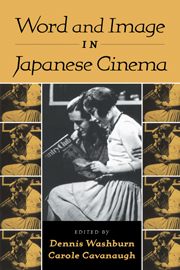Book contents
- Frontmatter
- Contents
- List of Illustrations
- Contributors
- Foreword: Outside Views of the Japanese Film
- Introduction
- PART ONE WORDING THE IMAGE/IMAGING THE WORD
- PART TWO REFLECTIONS OF IDENTITY
- PART THREE OUTSIDE THE FRAME OF CULTURE
- 12 Piss and Run: Or How Ozu Does a Number on SCAP
- 13 In the Realm of the Censors: Cultural Boundaries and the Poetics of the Forbidden
- 14 The Arrest of Time: The Mythic Transgressions of Vengeance Is Mine
- 15 The Frenzy of Metamorphosis: The Body in Japanese Pornographic Animation
- Selected Bibliography of Articles and Books in English
- Index
13 - In the Realm of the Censors: Cultural Boundaries and the Poetics of the Forbidden
Published online by Cambridge University Press: 01 March 2010
- Frontmatter
- Contents
- List of Illustrations
- Contributors
- Foreword: Outside Views of the Japanese Film
- Introduction
- PART ONE WORDING THE IMAGE/IMAGING THE WORD
- PART TWO REFLECTIONS OF IDENTITY
- PART THREE OUTSIDE THE FRAME OF CULTURE
- 12 Piss and Run: Or How Ozu Does a Number on SCAP
- 13 In the Realm of the Censors: Cultural Boundaries and the Poetics of the Forbidden
- 14 The Arrest of Time: The Mythic Transgressions of Vengeance Is Mine
- 15 The Frenzy of Metamorphosis: The Body in Japanese Pornographic Animation
- Selected Bibliography of Articles and Books in English
- Index
Summary
Over twenty years have passed since In the Realm of the Senses (Ai no korida) provoked a sensation at the 1976 Cannes Film Festival, where the film earned Nagisa Oshima the Best Director Prize. An unprecedented thirteen screenings were mounted to meet the public demand. Subsequent screenings at the New York Film Festival and in other countries spread the furor incited by the film's portrayal of explicit, continuous, and shocking sexual activity. Though shot in Japan with a Japanese cast and crew and based upon a tale that arose from the Japanese legal record, the film was never screened in Japan. Japanese censorship prohibited anything but a highly edited and otherwise circumscribed public showing. Nevertheless, the furor surrounding its production and reception arguably had its greatest impact in Japan. Even today this notorious exile haunts the film culture that produced it.
The impact of In the Realm of the Senses invites a paradoxical comparison with the screening of Rashōmon at the 1951 Venice Film Festival. Rashomon gained international recognition for the sterling achievement of Japanese cinema and led the way for other Japanese films, produced before and after, to cross cultural boundaries and assume a more influential and celebrated role in world cinema. In spite of its intentions, In the Realm of the Senses bore witness to the barriers blocking international exchange; its controversial reception in Japan illustrated the difficulty that arises in crossing boundaries and the power of culture to retract as well as to expand.
- Type
- Chapter
- Information
- Word and Image in Japanese Cinema , pp. 293 - 317Publisher: Cambridge University PressPrint publication year: 2000



